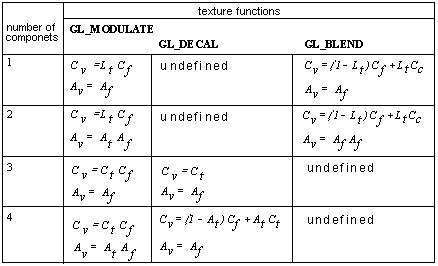
These functions set texture environment parameters.
void glTexEnvf(
GLenum target,
GLenum pname,
GLfloat param
);
void glTexEnvi(
GLenum target,
GLenum pname,
GLint param
);
void glTexEnvfv(
GLenum target,
GLenum pname,
const GLfloat *params
);
void glTexEnviv(
GLenum target,
GLenum pname,
const GLint *params
);
A texture environment specifies how texture values are interpreted when a fragment is textured. The target parameter must be GL_TEXTURE_ENV. The pname parameter can be either GL_TEXTURE_ENV_MODE or GL_TEXTURE_ENV_COLOR.
If pname is GL_TEXTURE_ENV_MODE, then params is (or points to) the symbolic name of a texture function. Three texture functions are defined: GL_MODULATE, GL_DECAL, and GL_BLEND.
A texture function acts on the fragment to be textured using the texture image value that applies to the fragment (see glTexParameter) and produces an RGBA color for that fragment. The following table shows how the RGBA color is produced for each of the three texture functions that can be chosen. C is a triple of color values (RGB) and A is the associated alpha value. RGBA values extracted from a texture image are in the range [0,1]. The subscript f refers to the incoming fragment, the subscript t to the texture image, the subscript c to the texture environment color, and subscript v indicates a value produced by the texture function.
A texture image can have up to four components per texture element (see glTexImage1D and glTexImage2D). In a one-component image, L (t) indicates that single component. A two-component image uses L (t) and A (t) . A three-component image has only a color value, C (t) . A four-component image has both a color value C (t) and an alpha value A (t) .

If pname is GL_TEXTURE_ENV_COLOR, params is a pointer to an array that holds an RGBA color consisting of four values. Integer color components are interpreted linearly such that the most positive integer maps to 1.0, and the most negative integer maps to –1.0. The values are clamped to the range [0,1] when they are specified. C (c) takes these four values.
GL_TEXTURE_ENV_MODE defaults to GL_MODULATE and GL_TEXTURE_ENV_COLOR defaults to (0,0,0,0).
The following function retrieves information related to glTexEnv:
The following are the error codes generated and their conditions.
| Error Code | Condition |
|---|---|
| GL_INVALID_ENUM | target or pname was not one of the accepted defined values, or when params should have had a defined constant value (based on the value of pname) and did not. |
| GL_INVALID_OPERATION | glTexEnv was called between a call to glBegin and the corresponding call to glEnd. |
Windows NT: Use version 3.5 and later.
Windows: Use Windows 95 and later.
Windows CE: Unsupported.
Header: Declared in gl.h.
Import Library: Link with opengl32.lib.
glBegin, glEnd, glTexImage1D, glTexImage2D, glTexParameter